|
 |
Photographic
Hardware
|
|
|
|
|
|
|
Nikon - The First
choice of small format cameras for many top
professional photographers for over five decades!
This website is
dedicated to the superb camera equipment produced by
Nikon over the decades. It is important to remember
that Nikon is, and always has been, primarily an
optical company and that the cameras that we
associate with the Nikon brand are effectively a
support structure for some of the finest lenses ever
produced. For various reasons many names have been
used by Nikon, sometimes to designate product type
ranges like Nikon for camera bodies and Nikkor for
lenses. Other names used by the company included
Nikkormat, Nikomat, Nikkorex and Nikonos for their
underwater cameras.
In July 1917 three independent Japanese optical
companies merged to become "Japan Optical Industries
Co. Ltd" (Nippon Kogaku Kogyo Kabushikigaisha), they
have made optics for use in all areas of industry
including camera lenses for Cannon and Bronica's
medium format cameras over the years. |
|
|
|
|
|
During WW2 the
company, like most others world wide, was required
to turn it's focus towards the requirements of it's
countries wartime requirements, this lead to an
increase in company size and an increased instrument
making capability. When WW2 ended Nikon had to
revert back to non military production, a decision
was made to create it's own cameras to make lenses
for, effectively giving the company it's own
dedicated end consumer base rather than relying just on
orders to supply other companies with optics. It is
of note that Nikon Corporation
only became the companies official name in 1988
and is now part of the Mitsubishi Group. |
|
|
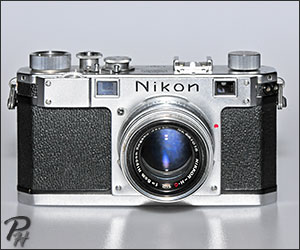 |
Nikon Rangefinder
Cameras and the famous Nikon F SLR
Nikons first
camera, the Nikon I, was a 35mm Professional
Rangefinder and it went on sale during 1948, it had the Leica
Rangefinder camera's general layout and
features but was by means an actual clone. The rangefinder
camera range was improved over the following twelve
years until it was replaced by the famous 1959
Nikon F SLR, this was effectively an SLR version of
their late rangefinder cameras. The
legendary performance and reliability of the Nikon F combined with
the true versatility of a system camera made the
Nikon F the choice of of professional photo
journalists world wide replacing the legendary Leica
M, and also NASA's choice of 35mm camera to take to the moon
on the 1971 Apollo 15
mission. |
|
|
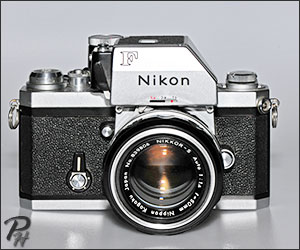 |
|
High speed
4fps motor-drives and bulk backs able to take 250
pictures without changing films resulted in the
Nikon F being highly suitable for high speed one off
events like a moon rocket taking off, no other
35mm SLR could compete, a true system camera, it
could be quickly re-configured to meet the
photographers requirements. Amateur photographers
always aspire to professional equipment, so by
introducing a cheaper range of high quality non system
35mm SLR cameras
that still utilised the Nikkor lens system, Nikon were able to
gain significant success with the less versatile, but
cheaper, Nikkormat range of camera bodies.
By constantly
improving the design and capability of the Nikon F's
Photomic light metering head the camera remained in
production until 1972 by which time the Nikon F2 had
become the professionals first choice of 35mm camera. |
|
|
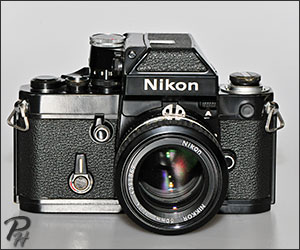 |
|
The Nikon F2
35mm SLR camera
The truly superb
1971 Nikon F2 camera is said by many to be the best 35mm
mechanical shuttered SLR ever produced, by the time
production ceased in 1980 in favour of the Nikon F3
over 80% of the worlds photojournalists are
estimated to have been using the camera, many of the
remainder still used the original "F" with
the Photomic FTn viewfinder head. The Nikon F2 did
every thing a Nikon F could do but was even more
reliable and slightly smaller with higher shutter
speeds and flash synchronisation speed. Over the ten
years of production of the Nikon F2 five different light metering viewfinder heads were
produced, they saw the transition from CdS metering
sensors to silicon photo diodes, and the use of moving
coil meters for exposure indication make the
transition to the new style LED indicators. |
|
|
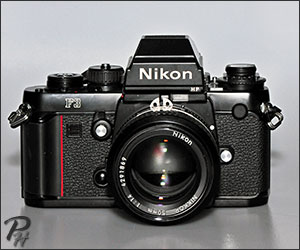 |
The Nikon F3 35mm
SLR camera
The introduction
of the Nikon F3 in 1980 lead to many Professional
photographers holding on too their trusty Nikon F2's
as if their lives depended on it, indeed many
thought their jobs really did! What was the problem?
It was the F3's use of a quartz timed electronic
shutter. The Nikon F2 had only required a
battery to power it's light meter, the new F3 had an
electronic shutter and if the battery went dead or
was unavailable for purchase "in field", it had only
a 1/60 mechanical shutter speed as a back up. The
fears about the battery were of course quite true
but the resolution was very simple, take ample
spares for the task in hand! After this somewhat
rocky start the camera proved an amazing success
remaining in production for an unbelievable twenty one
years, overlapping it's would be replacement's
production, the Auto focus Nikon F4, by three
years! |
|
|
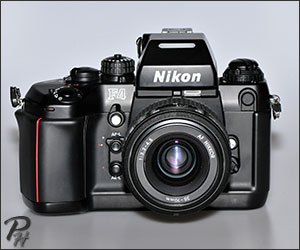 |
The Nikon F4 AF
35mm SLR camera
The Nikon F4 was a true milestone in Nikon's
camera history, it was the first AF 35mm
camera produced for the professional photographer
and it also had a built in motor drive, another
first for Nikon. The Nikon F4 represented a major
change for photographers, although it boasts the widest
lens compatibility of any Nikon camera before
or since, it needed a new range of lenses to be
purchased for it's AF capability to be used to
it's full advantage. Use of the TC16a adaptor
gave limited AF assist to many existing Manual
Focus lenses. Although the Nikon F4 has a built in motor-drive, it's frame rate
could be increased by changing the battery pack to a
higher voltage one, cameras fitted with these were
designated the F4s and F4e. The Nikon F4e variant could also
be used with a Bulk Film Back and Control Back. |
|
|
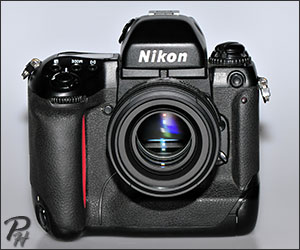 |
The Nikon F5 AF
35mm SLR camera
The Nikon F5 was
introduced in 1988, it was in many respects an
updated F4 with improved AF speed and even tougher
than the F4, it also had improved weather resistance
although not without cost, the finder was now fixed
and there was no choice of battery pack resulting
in a heavy camera that could not be made smaller and
lighter when a high frame rate was not required. Lens compatibility with older Nikkor
lenses was reduced leaving the Nikon F4
favoured by many photographers to this day over the
Nikon F5. When the camera went out of production in
2005 there was no real need for a replacement as the
digital age had truly arrived. Nikon however had
already committed to making one more "last-word"
35mm SLR camera, the Nikon F6, but for a somewhat
different user group. |
|
|
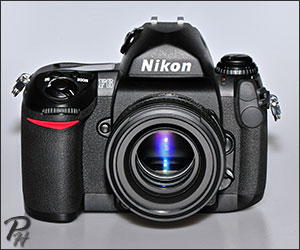 |
| The Nikon F6 AF 35mm SLR
camera
When the Nikon F6 was released in 2004 it was not
really aimed at professional photographers as they
had mainly switched to digital, but more towards the
wealthy amateur photographer who was a film die
hard. Nikon lightened the camera and reduced its
size but made it fully compatible with the latest VR
lenses and applied all the advances they had made
with auto focusing, exposure metering and
program modes that were being incorporated in their latest
generation of professional digital cameras. The
result of Nikons efforts have to be experienced to
be fully appreciated, the F6 is truly a dream to own,
hold and use. If you love the magic of film
photography you can not help but love this camera.
With the F6 Nikon have arguably really produced the
last word in 35mm SLR film cameras! |
|
|
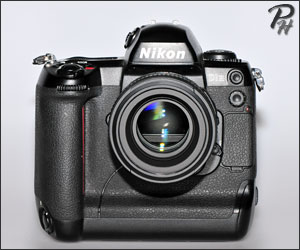 |
| The Nikon D1 AF SLR camera
The Nikon D1 of 1999 used the F5's AF
system and ergonomics, it was Nikon's first professional digital SLR camera, although it did not immediately make
35mm professional film cameras obsolete, the
writing was clearly "on the wall". In 2001 added
two new variants to it's D1 range, the D1h which was
even faster than the D1 at five frames
per second and addressed minor points with layout
and firmware, and the D1x which was slower at three
frames per second, less sensitive in low light but
increased the resolution too a
relatively massive 5.47megapixels. The Nikon D1x
remained on sale until mid 2004. It is of note that
the D1's sensor actually had 10.8 million
photo-sensors grouped down for unprecedented signal to
noise ratios, this was not made public at the time for
commercial reasons. |
|
|
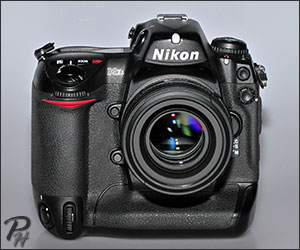 |
| The Nikon D2 AF SLR camera
When the D2H was released in July 2003 as a
successor the Nikon D1H, it had improvements across
the board and also used a low noise Nikon designed
4.1 megapixel JFET-LBCAST sensor, it also
incorporated an ambient light colour meter sensor in
it's pentaprism housing giving a very distinctive
look to the camera. The replacement for the Nikon
D1x, the D2x, did not arrive until late 2004 and
used a Sony 12.4 megapixel CMOS sensor. Early 2006
saw the D2H replaced with a slightly improved
camera, the Nikon D2Hs, the camera still
retained the 4.1 megapixel JFET-LBCAST sensor. In
mid 2006 the Nikon D2X was replaced with the
Nikon D2Xs which retained the existing Sony 12.4
megapixel CMOS sensor of the D2X, the main changes
were primarily firmware orientated. |
|
|
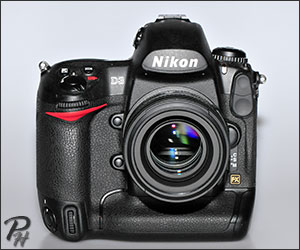 |
| The Nikon D3 AF SLR camera
The D3 was
introduced in August 2007 and notably lost the Nikon
D2's
ambient light colour meter whilst gaining a full
frame sensor. The Nikon D3 incorporated a 12.1
megapixel Sony CMOS sensor but was still even faster
than the D2Hs had been. As expected the camera was
superior to it's predecessor in all areas and
notably incorporated Nikon's ADR system which
addressed the digital cameras low contrast range,
effectively, for the first time, approaching that of
film. December 2008 saw the release of the 24.5
megapixel Nikon D3X which sacrificed the speed of
the Nikon D3 in favour of far more resolution at
lower ISO speeds. October 2009 saw the introduction
of the Nikon D3s which had gained the ability to
film HD video even in low level illumination, as
well as many other significant technical advances. |
|
|
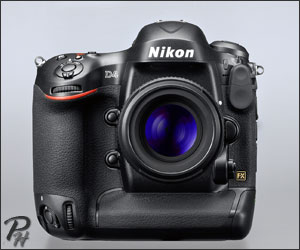 |
| The Nikon D4 AF SLR camera
As expected the Nikon D4 improves performance in
nearly all areas over the original D3, however when the 10fps 16.2 megapixel Nikon D4 was
announced
in January 2012 it had less impact with professional
photographers than the Nikon D3 had when first
announced, some
referring to it as the "D3 1/2". The expectation had
been for a resolution at long last approaching that required by
medium format professional camera users, this situation was not
helped the next month when the Nikon D800 semi-pro
camera was released boasting an impressive
36.3 megapixel full frame sensor many had expected
on the Nikon D4 initial version. It would seem
certain that Nikon will introduce another version of the
D4 to replace the D3x with a similar sensor
resolution to the D800 in the near future. |
|
|
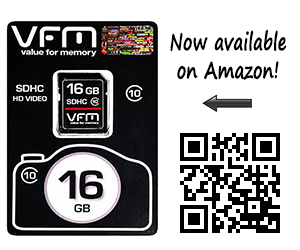 |
|
|
 |
Photographic
Hardware
|
|
|
|
|
|